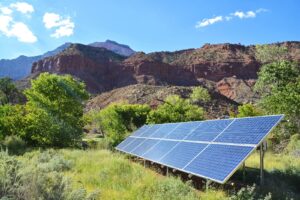Renewable energy projects in South Africa are being developed at a time of equally urgent focus on the country’s water resources; this is therefore a good time for developers to apply low impact development (LID) options in their stormwater management plans.
Solar farms that generate energy from arrays of photovoltaic panels present a good example of where the LID approach can add value, according to Jennifer Meneghelli, senior civil engineer at SRK Consulting. Often occupying many hectares of rural land, solar panels create a large impervious surface area that channels stormwater in a new way. Rainwater runs off these panels in sheets, falling from a height that can create scouring and erosion of soil – leading to contamination of water.Soft engineering
“One common traditional response to this water flow is hard engineering, using concrete channels to direct water away from the panels to a drain or watercourse,” said Meneghelli. “However, this approach is more applicable to an industrial site, where the aim is to keep clean water separate from dirty water; is not an optimal strategy for solar installations.” Rather than concentrating and collecting the flow of water running off the panels, the objective should be to dissipate and distribute the flow – in similar ways to before the panels were installed. A more sustainable methodology, based on LID, therefore looks to maintain the natural infiltration of stormwater into the soil as far as possible.Drip-line
PV plants are generally located in arid areas with high numbers of sun days per year, in order to achieve maximum performance. Therefore, rain occurs seldom, but must be managed when it does happen as storm events in these areas tend to be brief and intense. “Solar arrays are normally some distance above the ground, so the ‘drip-line’ where water cascades off the panels is often where most damage or gouging can be caused,” she said. “The lower the drip‑line can be to the ground, the better in order to reduce the erosive force; gravel can then be used to dissipate the force of the flow and prevent erosion.” Scarifying of the ground under the panels, and the planting of deep-rooted indigenous vegetation underneath the panels, can then help to maintain the health of the local ecosystem and enhance biodiversity. Rather than just planting grass, a variety of vegetation can create a meadow-type environment where natural pollination is encouraged. Interestingly, despite the heat emanating from the panels, the area beneath the panels is cooler as it is shaded from the sun, meaning that the soil has more moisture which fosters the growth of vegetation. Thus, it can be said that a micro-climate does develop within the PV plant and biodiversity is possible.
Construction impacts
“Most of the impact is in fact during the construction stage, and there are many opportunities to mitigate this impact,” explained Meneghelli. “Keeping excavation to a minimum is a good start, as well as any changes to the topography; this is usually quite easily manageable, as solar panel installation generally does not require earthworks or terracing.” Construction can also be conducted in stages, to limit the extent of areas being disturbed at any one time – as soil erosion has a direct effect on water quality. Sediment control traps can be established to help reduce erosion. While South Africa has no established practice yet on stormwater management in solar farms, the United States has made progress in developing guidelines in certain states. These frameworks encourage the use of the LID approach. “As local practitioners in this country, we have developed sustainable drainage systems for the urban environment – and this approach could be valuably extended to the renewable energy space,” she argued. “The need for LIP guidelines is becoming more pressing as there are likely to be many more of these renewable projects in South Africa in the near future.”Wind farms
While wind farms create a relatively limited impervious surface – amounting to only about 2% of the project site – there are still some ways to optimise stormwater management, she said. Again, most of the impact is experienced during the construction stage, when there is considerable soil disturbance for elements such as deep foundations and numerous hardstands. “It is advisable to create erosion protection measures around the large concrete base of the wind turbine towers,” she explained. “Burying the tower foundation below ground level will also allow a layer of topsoil to be placed over the concrete, and then revegetated to ensure better infiltration of stormwater.”SRK’s approach
Among the steps through which SRK would typically approach this type of project, she said, would be a site visit to assess the soil, vegetation, surface water features and existing infrastructure – followed by a hydrological assessment. The layout of the site and the positioning of PV panels or wind turbines would be assessed, along with their supporting infrastructure. This would confirm how well positioned the site was for the application of LID principles in the project’s stormwater management.Lessons learnt on renewable projects
- On solar farms using photovoltaic (PV) arrays, erosion control is required along the drip-line of panels.
- Erosion and sediment transport – as well as increased frequency and intensity of runoff – can occur if vegetation is not re-established under PV panels or over foundations of wind turbines.
- Intercepting stormwater at source through facilitating better infiltration is an important way to avoid the concentration of run-off flows.
- LID is readily applied to renewable energy facilities and should guide stormwater management strategies for these sites. Although there are currently no guidelines stipulated in regulations, this approach will help to prevent significant negative environmental impacts by these facilities.








